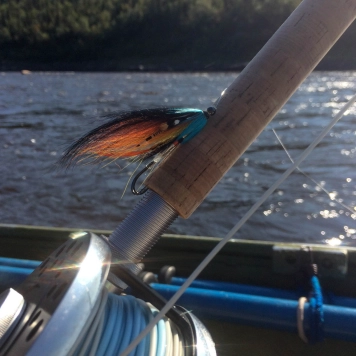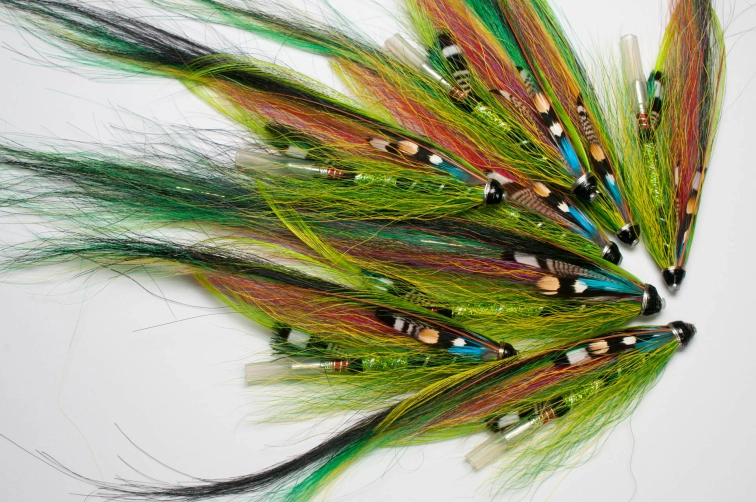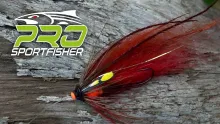Those of us who have fished tube flies for ages have no problem understanding the principle, but if you're new to tubes, the simple task of attaching a hook to a tube fly might seem hard to figure out.
Tube flies are actually built on a very simple principle. Tie the fly on a tube and attach (almost) any hook of your liking by the water. Change hooks depending on the fishing, the rules and the state of the current hook.
Simple, right?
Well, not always to people who are new to tube fly fishing. The ones of us who have done it many times don't consider it an issue at all, but people who haven't tried it or seen it, might not grasp the concept at all.
So here's the lowdown – and the expanded version – on tying a hook to a tube fly.
Tippet, tube, hook
The really simple principle is this: the fly is tied on a hollow tube with no hook attached. Once you are going to fish, you pass your tippet – already tied to the leader – through the tube front to rear of the fly, tie on the desired hook and pull the hook up to the rear of the tube.
That's it!
Your tippet is now attached to the hook, and just in front of the hook rides the fly. Pull the tippet, and you are pulling on the hook – not on the fly – but the fly of course follows.
So that's the really simple version. But there can be much more to it, which is covered below.
Junction tube
In most cases the hook will be sitting in a junction tube, which is a piece of soft silicone or plastic tube that slips onto the outside of the rear of the fly tube. When you pull the hook up to the rear of the fly, the hook eye and knot slips into this junction tube, which keeps it nicely in place, aligned with the fly and somewhat under control.
Mostly you will leave a short piece of the rear end of the fly tube bare to accommodate the junction tube.
The hook is still loose and the fly can slide up the tippet, but while you are casting, the junction tube holds it nicely.
On some flies tied on large diameter tubes, or when using small hooks, the junction tube isn't needed because the hook will fit into the tube that the fly is tied on.
Oftentimes the junction tube is loose and not attached permanently onto the fly, meaning that you can exchange that too, like for a bright colored tube or a fresh piece if the old one is worn.
Inner tubes
Many tube flies are tied with inner tubes, which are thin plastic tubes running inside the main tube and typically secured with a collar front and back.
On metal tubes these inner linings serve a rather obvious purpose: if they weren’t there the line would be rubbing against the metal, and almost no matter how well this was polished, the line could be weakened or damaged by the metal.
But the lining is also used on many plastic tubes, and some tying styles require that the fly is tied on both the inner and the outer tube. No matter what, the inner tube will not make a difference when mounting a hook on the fly other than maybe making it a little more difficult to thread the tippet through the fly.
Alternative junctions
Some tube flies do not allow for the junction tube to sit tightly on the fly. There might not be space or the fly tube can have a shape that doesn't allow for a good fit – like some types of bullet tubes. In that case you have a couple of alternatives, which might not serve as a hook hold, but will protect the knot which might otherwise rub against the rear end of the tube and get worn.
You can simply have a loose junction tube, which does not sit on the main fly tube, but just bumps up against it. The hook eye and knot will still slip into the tube, but the tube will not hold it onto the fly. In order for this to work, you need a fairly long junction tube, which reaches to the hook bend and still leaves a bit open to accommodate the knot.
An alternative is a narrow tube, which will not slip over the hook eye. This tube can also simply be a small cylindrical pearl, which leads to the last alternative: an actual pearl. Choose a soft plastic pearl, which will protect the line and knot and won’t break in the cast. Glass and hard plastic may shatter, wood will soak water and eventually crack.
Hooks
You can in principle use any hook for a tube fly as long as it's suitable in size, but certain hook types are preferred by tube fly anglers.
First and foremost the hooks are typically straight eyed, meaning that the eye doesn't bend up or down, but is parallel to the shank. This makes the tippet leave the eye in a straight line and the hook sit flush with the tube and the fly. Some knots – like a Turle knot – will allow the line to leave an up or down bent hook eye straight, but the bent eye may still be difficult to get to sit right on the fly.
Secondly hooks with small or narrow eyes are preferred. This makes it easier for the hook eye and knot to slip into the junction or main tube.
The hooks are generally also the short shank type. The advantage of this is that the hook will sit close to the fly and that there will be no lever effect once the fish is hooked, disabling the fly from working itself free by wiggling with the added force of a long shank.
Hooks can be singles, doubles or trebles.
Lots of manufacturers have special hooks designed for tube flies in their assortment.
Single hooks
Single hooks are often used due to regulations and rules, which prohibit the use of multi-point hooks on many waters. Personally I mostly choose singles for tube flies because I don't care much for the added havoc that a multi-point hook can wreck in the mouth of a fish. I also like smaller hooks rather than large and sturdy ones, and still have to experience a fish strong enough to straighten a hook. Of course you need to adjust the hook size to the quarry and fly size. You can use specially designed tube singles or some of the many short shank, wide gape carp or saltwater hooks. Most people fishing tube flies in the salt use single, stainless hooks.
Double hooks
The doubles are mainly a Scandinavian phenomenon, but are finding their way out in the world. These are specially made, short shank hooks, but with two hook points. The main purpose of this is to get a better chance of a hookup but without the risk of trebles catching both the upper and lower jaw of a fish, which will often lead to a bad hook hold and an increased risk of loosing the fish. Doubles are widely used in Denmark, Iceland, Sweden and also seen in Norway. Some anglers mount the doubles “upside down”, allegedly giving a better hook set, but my personal experience is that the hook turns to an arbitrary position anyway unless it's very solidly stuck in the junction tube. Also, many flies are tied “in the round” and aren’t necessarily oriented in the water as they were in the vise.
Treble hooks
Trebles are the most common type of tube hooks, and the group where you will find the largest assortment of dedicated tube hooks. These are available in many styles and sizes and are often used on salmon tube hooks. Trebles are often chosen in fairly small sizes in relation to the fly. A small treble hook is able to grab and hold to a surprising extent, and even the daintiest treble is surprisingly strong and gives a very firm and secure hookup. But as I wrote: both small and large trebles can damage the fish quite terribly, and I prefer to avoid them unless I plan on killing and keeping the fish.
Barbs
Like choosing the number of hook points vary according to temper and rules, selecting barbless hooks can also be a question of local rules prohibiting the barbs, or it can be a matter of personal choice. Barbless does definitely increase the risk of a fish coming loose, especially it the line goes slack, but will on the other hand enable you to easily unhook the fish and release it fairly unharmed.
Barbless hooks designed for tubes are still rare, especially in trebles or doubles, but pinching down the barbs on regular hooks will give you a good alternative if you want to fish without barbs. Many manufacturers are increasing their selection of barbless hooks, and that often includes tube hooks.
Attaching the hook
As already mentioned the tippet is threaded through the tube and tied onto the hook. You can use whichever knot you prefer, but a standard Trilene or Palomar knot will do well. Loop knots aren't good or even needed here, and even though the humble clinch knot might seem suitable, it's not a particularly strong knot and shouldn't be used.
The knot should be compact and sit close to the hook eye. Guiding knots like the Turle knot, which are often used on salmon flies aren't suited for the straight eye tube hooks. If you on the other hand are using an up or down eye hook, the guiding knots are perfect for this purpose.
Changing the hook
One advantage of the tube fly is that the hook can be changed. Fishing for salmon or steelhead often means fishing rough and rocky streams, and contact with the bottom isn't rare. The fine tips of a hook will easily become blunt and sharpening is only possible so many times. So if the hook is too dull, simply cut it off and attach a new one.
Storing flies and hooks
Another great advantage of the tube is that you can store the hook-less flies in almost any manner that suits you:
- ordinary fly boxes – mount a hook in the junction tube and poke the fly into the slit or foam.
- special tube fly boxes designed to mount the hook-less tubes in grooves or on rods.
- compartment boxes that will hold the flies and hooks separately.
- flies in Ziploc bags and hooks in a small box or canister.
Personally I usually bring a small box with compartments with different hook types and sizes and a single compartment with extra junction tubes in different colors, and then have the flies in bags or a small fly box with compartments.
- Log in to post comments
















